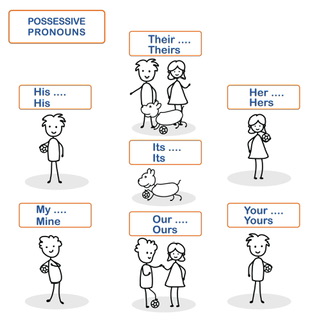We'll be back in a bit !
The system is currently undergoing a routine upgrade to ensure you get the best learning experience. The maintenance is expected to continue till 8:00 pm. Please check back later.
Thank you for your understanding!

Your, mine, and theirs are all examples of possessive pronouns. Possessive pronouns are often used as either direct objects or indirect objects. In common use, the possessive pronouns "my" and "my" are the most common. So, it is common practice to denote ownership of an item by use of a possessive pronoun (which can be either singular or plural). Examples of possessive pronouns are their, her, our, and theirs.
A possessive pronoun is used to show ownership of an object or person. It's a mark of exclusivity, meaning no one else in the world has it. Possessive pronouns can be used in place of noun phrases to save redundancy.
Humans have a well-documented propensity for placing a high value on their social networks and material assets. Possessive pronouns are used to show who or what belongs to someone.
Adding an apostrophe and an "s" to the end of a word typically suffices to make it possessive. One may also show ownership using pronouns. None of those things can be done by adding an apostrophe or an s. Some pronouns are reserved for indicating ownership of a particular person, animal, or item.
Possessive pronouns can go by the titles independent or absolute possessive pronouns. The primary difference between them and possessive adjectives is that possessive pronouns require an accompanying noun when used alone.
By reserving possessive pronouns for cases when we know with absolute certainty that we are referring to a specific item, we can keep the text free of unnecessary repetition.
Examples of singular possessive pronouns: are mine, yours, hers, his, its, etc.
Examples of plural possessive pronouns: are theirs, ours, etc.
Let's have a look at some instances to see how possessive pronouns are used in context.
That is her drink and this one here is my drink.
That is her drink and this one here is mine.
Do you know who is the owner of this book?
Do you know who owns this book?
This little girl is her daughter, and that little girl is mine.
This one belongs to her, and that young girl is my daughter.
I made rice last night, but it's not as good as your rice.
I made rice last night, but it wasn't as good as yours.
Ria said we can stay at her house, but I don’t know which one is her house.
Ria said we can stay at her house, but I don’t know which one is hers.
Why not put an end to the never-ending argument regarding when to use "its" and when to use "it's"?
The addition of an apostrophe and a "s" to show possession is counterintuitive to most people learning English as a second language. The sole caveat at this point is the fact that the pronoun "it" functions slightly differently.
The possessive form of "it" is "its," not "it's," in contrast to other possessive nouns. The word "it's" in this context is short for "it is." It's similar to other contractions like "don't," "can't," "won't," and "you're," all of which shorten their respective longer forms.
Contraction can refer to the physical process of extending or shortening a muscle fiber, or it might be the acoustical process of merging the sounds of two longer syllables into a single shorter word. The effect of a uterine contraction during labor is a good example. Yet, "it is shortened to it" (thus the term "it").
Possessive names are those that indicate ownership or possession. Possessives have the most convoluted rules regarding when and where to use the apostrophe. They vary somewhat from one form of possessive to another, depending on the original name. These basic rules are as follows: A contraction is a shortened form of a phrase or group of words that eliminates letters or sounds. When a letter is omitted from a contraction, it is denoted by an apostrophe.
Most commonly, we shorten phrases by joining them together with a verb, an excipient, or a modal:
It would be = It’d be
I have = I’ve
If you are = If you’re
You can not = You can’t
When something is someone's or something's, you show possession by using the apostrophe and the letter "s."
Ans. It's a typical typo to forget the apostrophe while writing the possessive. It is easy to confuse it with its apostrophized contraction. Therefore, you should never use an apostrophe in front of a possessive adjective.
Ans. In this article, we will look at the seven different categories of pronouns. All authors, native and non-native speakers of English alike, need to be familiar with the seven different kinds of pronouns: personal, demonstrative, interrogative, relative, indefinite, reflexive, and intensive.
Ans. Indefinite pronouns include no one, nobody, nothing, and nowhere. We say there is no one there, nobody there, no objects there, and no place there. No one ever goes to see her, so we use them with a singular verb.
